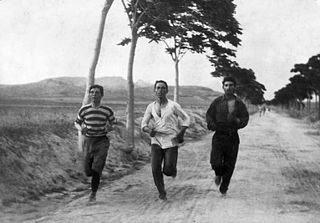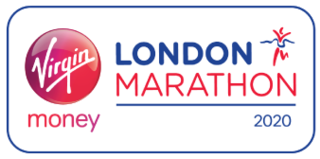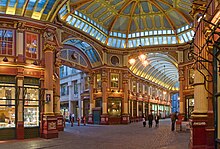
Athletics is a group of sporting events that involves competitive running, jumping, throwing, and walking. The most common types of athletics competitions are track and field, road running, cross country running, and racewalking.

The London Marathon is an annual marathon held in London, United Kingdom, and is the 2nd largest annual road race in the UK, after the Great North Run in Newcastle. Founded by athletes Chris Brasher and John Disley in 1981, it is typically held in April, although it moved to October for 2020, 2021, and 2022 due to the COVID-19 pandemic. The largely flat course is set around the River Thames, starting in Blackheath and finishing at The Mall. Hugh Brasher is the current Race Director and Nick Bitel its Chief Executive.

The marathon is a long-distance foot race with a distance of 42.195 km, usually run as a road race, but the distance can be covered on trail routes. The marathon can be completed by running or with a run/walk strategy. There are also wheelchair divisions. More than 800 marathons are held throughout the world each year, with the vast majority of competitors being recreational athletes, as larger marathons can have tens of thousands of participants.

The Mall is a road in the City of Westminster, central London, between Buckingham Palace at its western end and Trafalgar Square via Admiralty Arch to the east. Near the east end at Trafalgar Square and Whitehall it is met by Horse Guards Road and Spring Gardens where the Metropolitan Board of Works and London County Council were once based. It is closed to traffic on Saturdays, Sundays, public holidays and on ceremonial occasions.

Kenenisa Bekele Beyecha is an Ethiopian long-distance runner. He was the world record holder in both the 5000-metre and 10000-metre from 2004 (5,000m) and 2005 (10,000m) until 2020. He won the gold medal in both the 5000 m and 10,000 m events at the 2008 Summer Olympics. At the 2004 Olympics, he won the gold medal in the 10,000 m and the silver medal in the 5000 m.

The men's marathon race of the 1908 Summer Olympics took place in London on 24 July 1908. Johnny Hayes won after Dorando Pietri was disqualified for having received assistance before the finish line. For the first time in an Olympic marathon, the distance was 26 mi 385 yd (42.195 km), which would become the standard distance in 1921. 75 competitors entered the race, of whom 55 from 16 nations started, with 27 from 11 nations finishing. NOCs could enter up to 12 athletes. The United States and South Africa each won their first Olympic marathon medals.

The men's marathon at the 1904 Summer Olympics in St. Louis, United States, took place on August 30 of that year, over a distance of 24.85 miles (40 km).

The Riga Marathon is an annual road marathon held in Riga, Latvia, since 1991. A flat, single-lap marathon course in the Baltics' largest city. The marathon course has been measured and certified by AIMS, the Association of International Marathons and Distance Races and is categorized as a Gold Label Road Race by World Athletics. All courses are traffic-free. Rimi Riga Marathon is one of the fastest-growing marathons in Northern Europe. In 2019, there were 25 659 participants over five different distances from 82 countries.

The Polytechnic Marathon, often called the Poly, was a marathon held annually between 1909 and 1996, over various courses in or near London. It was the first marathon to be run regularly over the distance of 26 miles, 385 yards which is now the global standard. A total of eight world marathon bests were set in the Poly, including the first authenticated time under 2 hours, 20 minutes which had been regarded as the marathon equivalent of the four-minute mile. At the time of its demise in 1996, the Poly was Europe's oldest regular marathon. It had seen more world records and had been run over 42.195 kilometres (26.219 mi) more often than any other marathon.

The women's marathon at the 2012 Olympic Games in London was held on the Olympic marathon street course on 5 August.

The men's marathon at the 2012 Olympic Games in London took place on the Olympic marathon street course on 12 August, the final day of the Games. One hundred and five athletes from 67 nations competed. The event was won by Stephen Kiprotich of Uganda, the nation's first Olympic men's marathon victory and the nation's only medal in 2012. Kenya earned its fourth and fifth medals in five Games, with Abel Kirui's silver and Wilson Kipsang's bronze.

Paulo Roberto de Almeida Paula is a Brazilian long-distance runner who competes in marathon races. He finished 8th at the 2012 Olympics and 15th at the 2016 Rio Olympics. He is a member of the Cruzeiro Sport Club.
Abraham Kiprotich is a Kenyan-French long-distance runner. At the 2012 Summer Olympics, he competed in the Men's marathon but did not finish.

Abraham Kiplimo is a Ugandan long-distance runner. At the 2012 Summer Olympics, he competed in the Men's 5000 metres, finishing 24th overall in Round 1, failing to qualify for the final. At the 2011 World Championships in Athletics he failed to get past the heats of the 5000 m.

The marathon at the Summer Olympics is the only road running event held at the multi-sport event. The men's marathon has been present on the Olympic athletics programme since 1896. Nearly ninety years later, the women's event was added to the programme at the 1984 Olympics in Los Angeles.

Stephen Scullion is an Irish middle-distance and long-distance runner.

The 2020 London Marathon was the 40th running of the annual marathon race in London, United Kingdom, which took place on 4 October 2020. Due to the COVID-19 pandemic, the race was postponed from 26 April and only allowed elite participants; the mass participation event was cancelled. The event used a different course from usual, consisting of multiple laps around St James's Park.

The 2021 London Marathon was the 41st running of the annual London Marathon on 3 October 2021. Due to the COVID-19 pandemic, the race was postponed from April until October to maximise the chances of a mass participation event.
The 2021 British Athletics Marathon and 20 km Walk Trial was held on 26 March 2021 as a trial event for British athletes to qualify for the delayed 2020 Summer Olympics in Tokyo. It was the first time since 1980 that a dedicated marathon trial event was held, and the courses consisted of multiple laps around Kew Gardens in London.
The 2022 London Marathon was the 42nd running of the annual London Marathon on 2 October 2022. Due to the COVID-19 pandemic the race was postponed from April until October to maximise the chances of a mass participation event. The elite men's and women's event were won by Kenyan Amos Kipruto and Ethiopian Yalemzerf Yehualaw respectively. The wheelchair races were won by Swiss athletes Marcel Hug and Catherine Debrunner respectively, both in course record times. Over 40,000 people finished the mass participation event.




























